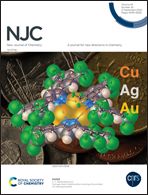Activated carbon fibers as a support for nickel diimine complexes and their application in ethylene oligomerization†
Abstract
In this work, we demonstrate the synthesis and characterization of a new class of β-diimine ligand combined with the alkoxysilane group CPTMS ((3-chloropropyl)trimethoxysilane), covalently anchored to the surface of activated carbon fibers (ACF) by interaction with the hydroxyl groups of the surface. The nickel β-diimine dibromo (N,N-bis(2,6-diethylphenyl)-2,4-pentanedimine)nickel(II) complex employed in this study has an interesting catalytic activity and selectivity in producing light olefins, when applied in ethylene oligomerization reactions in a homogenous and anchored to the ACF in a heterogeneous medium. The ligand was characterized by 1H NMR, elemental analysis and infrared, while the catalytic precursor was analyzed by infrared and X-ray absorption spectroscopy (XAS), and the activated carbon fibers (ACF) employed as a support of this catalytic precursor were analyzed by SEM, adsorption/desorption of N2, elemental analysis, and FAAS. The catalytic precursor is shown to be active in ethylene oligomerization reactions, with excellent selectivity (above 90%) for α-C4. Tests in the heterogeneous medium of the complexes, anchored to the ACF for ethylene oligomerization, demonstrated also excellent selectivity, above 95%.



 Please wait while we load your content...
Please wait while we load your content...